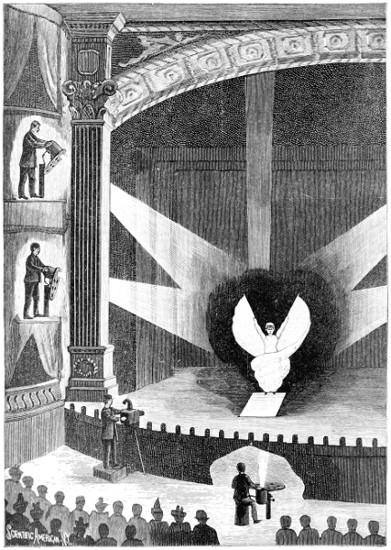Please see the Transcriber’s Notes at the end of this text.
MAGIC
STAGE ILLUSIONS AND SCIENTIFIC DIVERSIONS
INCLUDING TRICK PHOTOGRAPHY
COMPILED AND EDITED BY
ALBERT A. HOPKINS
EDITOR OF THE “SCIENTIFIC AMERICAN CYCLOPEDIA OF RECEIPTS, NOTES AND QUERIES,” ETC.
WITH AN INTRODUCTION BY
HENRY RIDGELY EVANS
AUTHOR OF “HOURS WITH THE GHOSTS; OR, XIX. CENTURY WITCHCRAFT,” ETC.
WITH FOUR HUNDRED ILLUSTRATIONS
LONDON
SAMPSON LOW, MARSTON AND COMPANY
LIMITED
St. Dunstan’s House,
Fetter Lane, Fleet Street, E.C.
1897
Copyright, 1897, by
MUNN & CO.
NEW YORK
ENTERED AT STATIONERS’ HALL, LONDON, ENGLAND
All rights reserved
The articles used from the Scientific American and the Scientific American Supplement
are copyrighted
Printed in the U. S. A. by
J. J. Little & Co., New York City
PREFACE.
It is believed that the present work occupies a unique field in the extensiveliterature of magic. There are already a large number of treatises onnatural magic and legerdemain, but in most of them very little attention hasbeen given to the exposé of stage illusions, which are of great interest as theyare so largely based on ingenious applications of scientific principles. Optics,mechanics, sound, and electricity have all been pressed into service by the finde siècle prestidigitateur. In the present work great attention has been paidto elaborate tricks of this nature, and in many cases the exposés have beenobtained from the prestidigitateurs themselves. In the first few chapters manyof the best illusions of Robert-Houdin, Dr. Lynn, Professor Pepper, Bautierde Kolta, Heller, Herrmann, Maskelyne and Cooke, and Kellar will be foundclearly explained.
Conjuring tricks have been by no means neglected, but the number ofthem which are given has been limited, owing to the fact that many of thebooks on magic have gone into this subject quite extensively. Ventriloquism,shadowgraphy, mental magic, etc., will also be found treated in the presentwork.
The chapters relating to “Ancient Magic” take up the temple tricks ofthe ancient Egyptian, Greek, and Roman thaumaturgists, as well as a numberof automata which are very interesting in view of their very early epoch. Itis believed this will be found a particularly entertaining feature of the book.
There is always a great charm about the stage, and the methods of producingthe effects which give realism to the drama. The chapters devoted to“Theatrical Science” will be found to contain a very large number of effectsand illusions, many of which are here presented for the first time. Thus
